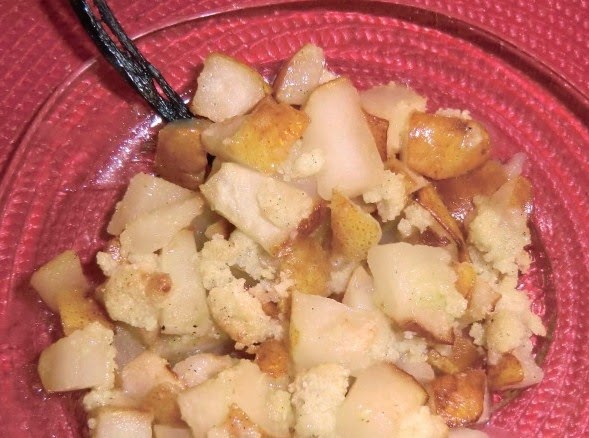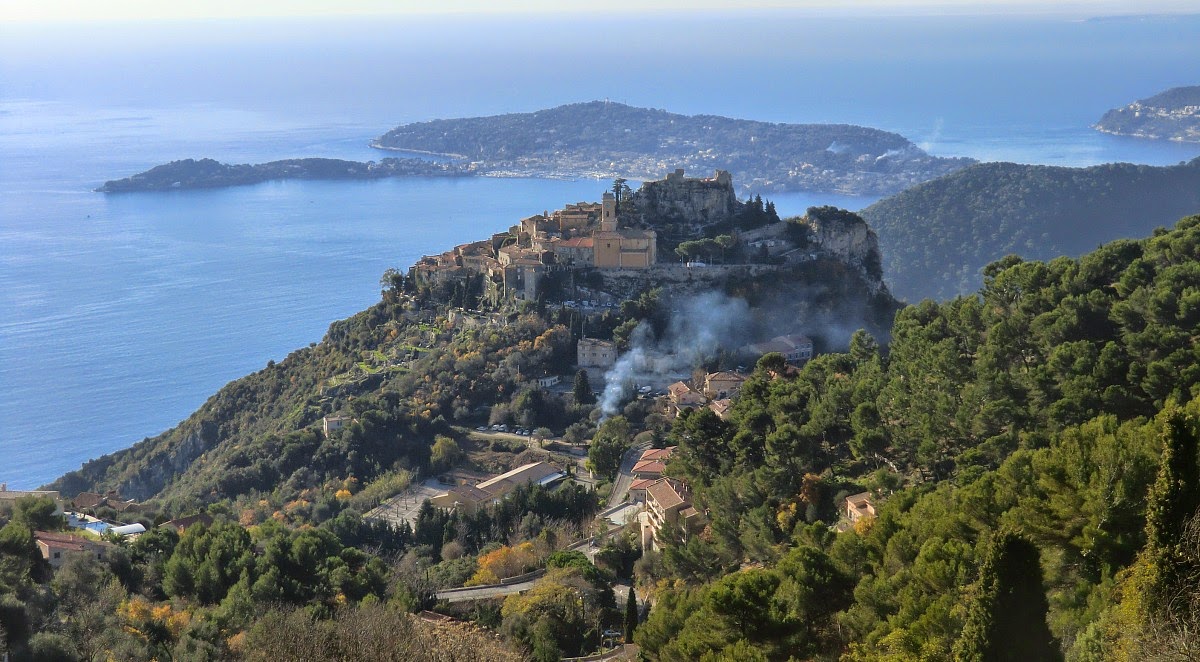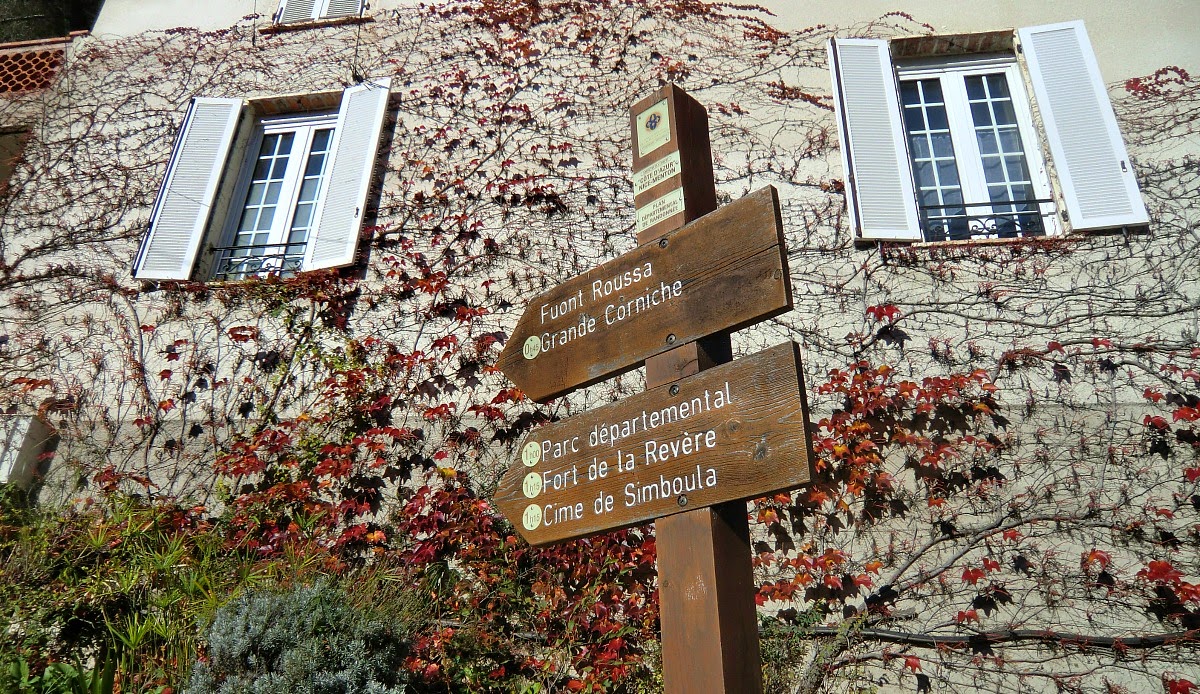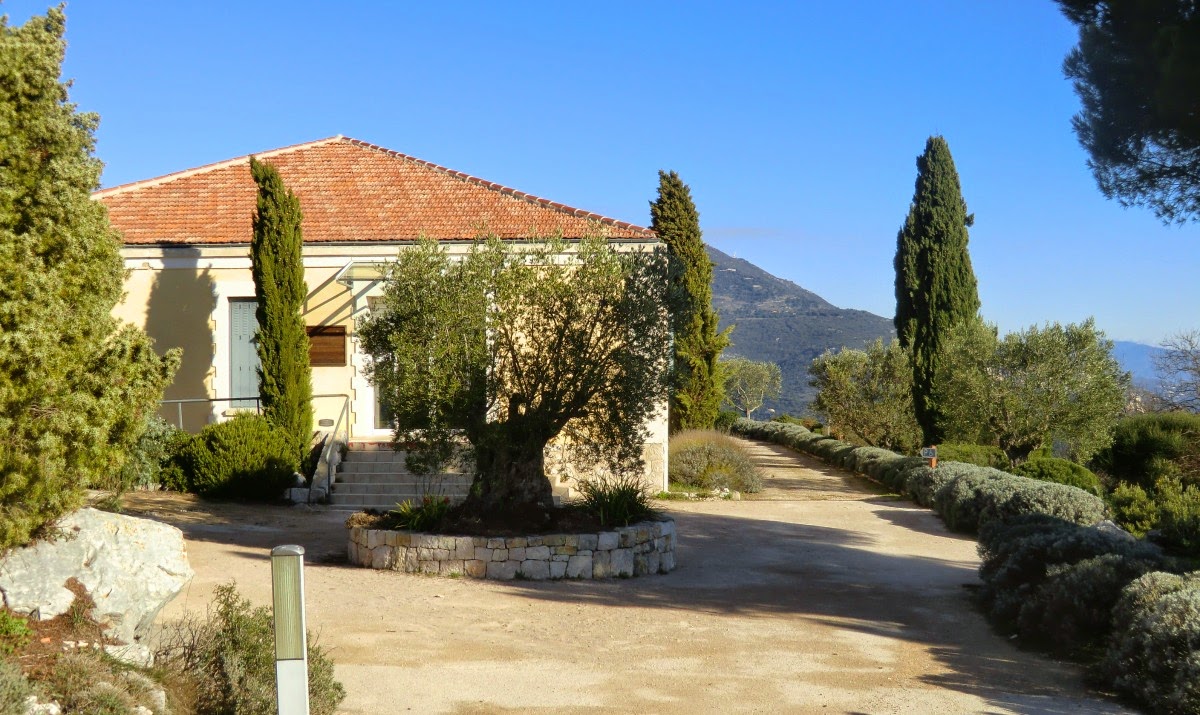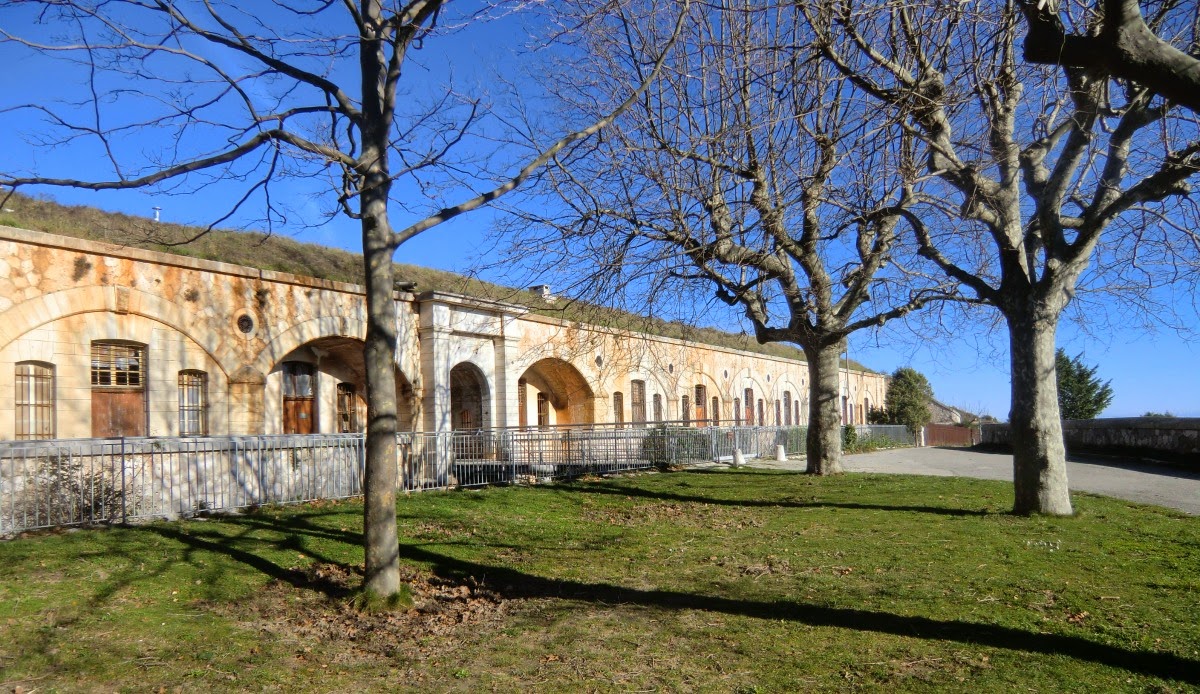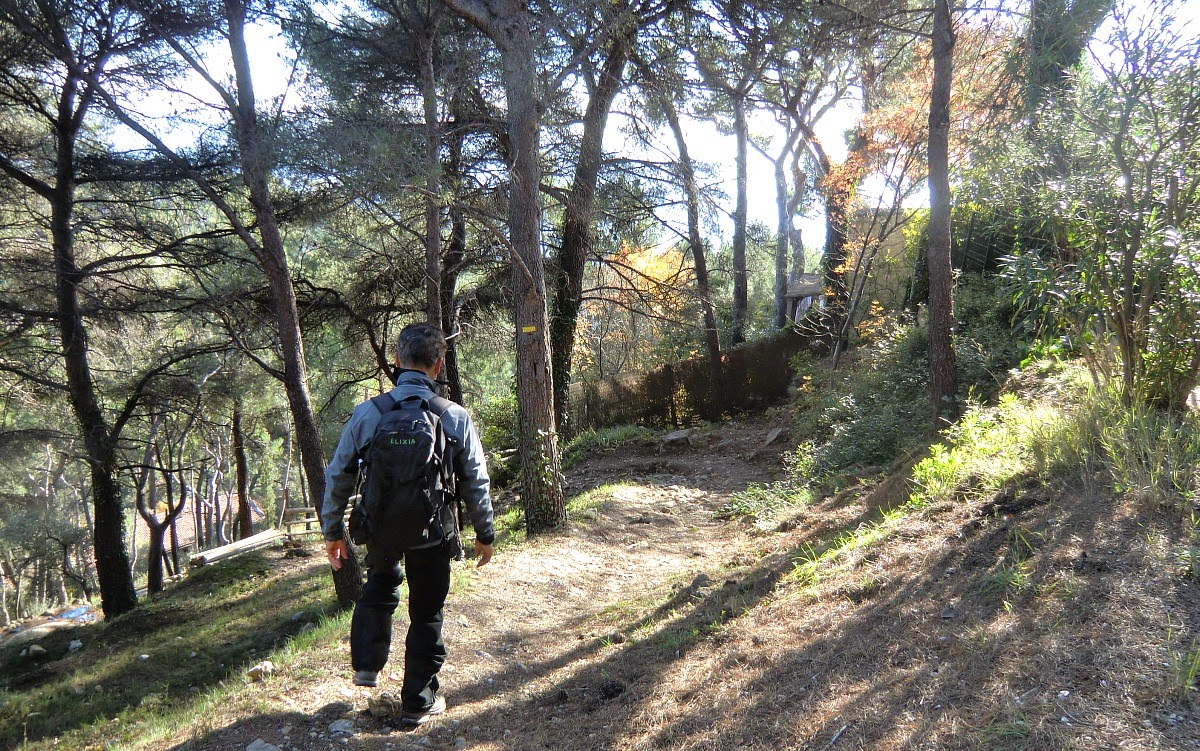
This is a winter fish recipe when you may prefer a spicier and more substantial dish. The recipe is loosely adapted from a French magazine. I have substituted the ingredients from the Pyrenees with local ingredients from Nice with an Italian twist.
But I have kept Piment d’Espelette AOC which is a mildly hot chili pepper from the northern territory of the Basque country. You can substitute this with some other mild/medium chili pepper powder.
2 servings
2 sea bass filets, about 150 g each
400 g tin of small white beans, eg. Bonduelle Haricots blancs préparés
1 red bell pepper, finely chopped
1 shallot, finely chopped
1 clove garlic, minced
1 tbsp rapeseed oil
1 tsp Piment d’Espelette
50 g Italian pancetta cubes
2 tbsp olive oil
Freshly ground black pepper
Chives to decorate
Lemon wedges to serve
Preheat the oven to 200⁰ C.
In a large frying pan warm 1 tbsp rapeseed oil over medium heat. Add the finely chopped bell pepper and pancetta cubes and fry for about 5 minutes, stirring now and again. Reduce the heat to medium-low; add the shallot, garlic and Piment d’Espelette. Sauté for 10 minutes until the vegetables are soft.
Rinse the beans under running water and add to the frying pan. Grind a few rounds of black pepper and stir well. Cover and let become thoroughly heated over medium heat.
Meanwhile arrange the sea bass filets on an ovenproof dish covered with baking paper. Drizzle 2 tbsp olive oil over the filets and bake in oven for 10- 12 minutes, depending on the thickness.
Wash and dry the chives. Cut them finely, saving a few sprigs for decoration.
Divide the bean-vegetable mixture on the plates and arrange the sea bass filets on top. Decorate with chives and serve with lemon wedges.
Choosing the five top hikes on the Riviera is a difficult if not an impossible task. There are just so many candidates. This is purely our own subjective selection of walks and hikes that we have done in the nearby mountains. The great coastal trails would certainly deserve their own list.
In normal weather conditions, the hills and mountains close to the coast in Alpes Maritimes can be climbed all year round. Cold spells can sometimes bring snow to surprisingly low altitudes. After rainfall, trails can be icy and slippery especially in the shade. On a clear and crisp winter day, the blue skies usually prevail all day whereas summer heat often brings high cumulus clouds above the mountains; afternoon thunderstorms are not infrequent during the summer months..
Here's our selection:
1. Hike above Èze-village
This is a classic Riviera hike which offer super view over the French Riviera a few km east of Nice. It is specially rewarding on a sunny winter day. The hike featured here was done in December. The hike itself is moderate, about 2, 5-3 hours, and you can easily combine it with a visit to Èze-village.
2. Walk above Gourdon
This easy walk, about 2, 5 -3 hours starts from the charming hilltop village of Gourdon. Although a bit touristic in the summertime, the village is pretty quiet in the winter; mostly locals seem to visit the restaurants at the entrance of the village
3. The Baou above St-Jeannet
The ascent from St-Jeannet to Baou de St-Jeannet gives you first a good workout and from the summit great views over the Var Valley, Antibes etc. From the top, you have various options back to the village: the shorter route along the eastern side of the Baou or the longer route along the western side as featured in our blog. Parking is almost impossible during weekends and market days even in winter.
4. Hike above Menton
This moderate 3 hour hike starts from the village of Castellar above Menton. The highest point is quite near the coastline on the Italian border offering breathtaking views over Menton as well as over the Italian coast.
5. From Peille to Cime de Baudon
Even though this ascent to Cime de Baudon is only 620 m in vertical climb it is steep in some parts requiring some easy scrambling. On a clear winter day, you can simultaneously see the snow capped Mercantour peaks and Corsica in the south.

This recipe is inspired by the small yellow plums, mirabelles de Lorraine, that have appeared in our local supermarket. I googled the mirabelles, and they said that Lorraine is the only region in the world where there is such a high concentration of Mirabelle plum trees. The Lorraine region produces 70 % of the Mirabelle plums’ world production.
The Mirabelle plums taste delicious; they seem to just melt in the mouth. No wonder chefs are still inventing
new recipes based on the Mirabelle plums. The following recipe is my twist from a cooking booklet from our local supermarket.
2 servings
2 whole chicken legs, pref. organic, cuisses de poulet fermier
About 200 g Mirabelle plums
1 medium onion, chopped
1 clove garlic, minced
2 tbsp rapeseed oil
75 ml white wine
1 tsp ground ginger
A pinch of saffron
¼ tsp salt
Freshly ground black pepper
Parsley to decorate
In a heavy casserole, cocotte, warm 2 tbsp rapeseed oil over medium heat. Add the chicken legs and cook for 10 minutes until nicely coloured on both sides.
Add the onion, garlic, white wine, ginger, saffron, salt and pepper in the casserole and bring to a boil. Then reduce the heat, cover and let simmer for 20 minutes.
Wash and dry the Mirabelle plums. Cut them in halves, remove the stones and add to the casserole. Cover and gently simmer for 10 minutes.
Divide the chicken legs and Mirabelle plums on the plates, decorate with parsley and serve with new potatoes or brown rice.
This is a great and easy walk on a sunny winter day! Park your car at the entrance to Gourdon (758 m), a
charming hilltop village. Gourdon offers breathtaking views, has a few restaurants and small somewhat touristic shops. We suggest that you combine your visit to Gourdon with a less than 3 hour hike to Plateau de Cavillore.
Start your hike by following the road to Cassols (RD 12) for about 100 m, then turn right and follow a path first passing a small residential area. The trail then ascends along a slope to the eastern part of Col de Cavillore. All parts of the trail are well marked with yellow. From the Plateau de Cavillore you have magnificent view over the French Riviera.
The trail turns left and continues along the plateau to the western part of Col de Cavillore. There are signposts showing “Circuit de Cavillore” and cairns to facilitate the orientation.
The zigzagging trail back down is wide and well visible. This part of the route might also be a natural spot for picnic while enjoying the scenery. If the wind is too strong and cold, you can always try one of the restaurants in Gourdon.
The trail then crosses the RD 12 road at signpost 105. You descend further along a narrow dirt road passing soon the ruins of Chapel St-Vincent. From here, the starting point can be reached in about 15 min.
Total hiking time: 2, 5 – 3 hours
Vertical climb: 300 m
Description of the hike in French
Map: IGN Cannes-Grasse Côte d’Azur 3643 ET
This warming and tasty dessert is perfect for dark and cold winter evenings. It is super-quick and easy to make.
For this dessert I prefer Williams pears. Wash the pears well, but do not peel them. Most of those important antioxidants are just underneath the skin and you do not want to peel them away.
In France you can buy poudre d’amande in ordinary supermarkets. Poudre d’amande could be translated as almond flour, and is used a lot in French pastries. Elsewhere you usually have to grind the almonds yourself into flour.
2 servings
2 Williams pears
1 tbsp rapeseed oil
For the crumble:
1 heaped tbsp sugar
1 heaped tbsp almond flour, poudre d’amande
1 heaped tbsp flour
2 tbsp rapeseed oil
½ vanilla pod
Wash the pears well and cut into small cubes. In a frying pan, warm 1 tbsp rapeseed oil over medium- high heat and quickly sauté the pear cubes. Line a smallish ovenproof dish with baking paper and pour the pear cubes in it.
Preheat the oven to 210⁰ C.
In a bowl mix the sugar, flour and almond flour. Cut a half vanilla pod length-wise and scrape the seeds into the sugar- flour mixture. Mix well, and then add 2 tbsp rapeseed oil and mix into a paste. Scatter this on top of the pear cubes.
Bake in oven for 15 minutes until golden. Serve the crumble warm. Vanilla ice cream would go nicely with the crumble.
Today’s ascent to Cime de Baudon (1264 m) starts from the hillside village of Peille (650m) about 25 km by road from Nice. The villages of St Agnes and Gorbio are also possible starting points. We have previously hiked to Cime de Baudon from Gorbio. Today’s ascent is shorter and the vertical climb only 620 m versus 900+ m from Gorbio.
Park your car in the upper part of the village. The trail starts as the stairs of St Bernhard and continues as a small road called Barri to Col St Berhard (750 m; 15 min walk from the village). From this point turn right and ascend along a path in a beautiful pine forest. Follow closely the yellow signs (which are numerous on this route) and signposts. The path reaches a plateau with a signpost at 974 m. From here, the ascent is steeper and requires some easy
scrambling when climbing the southern slope before the summit.
On the mountaintop, there is a table d’orientation and a 360 degree panoramic view. Thanks to the clear January weather, we were even able to see Corsica. It has been said to be just refraction due to atmospheric factors. However, if the atmosphere is not taken into account we calculated that from the altitude of 1000m a mountain range of 2000m (Corsica’s highest peak Monte Cinto is 2706 m) should be well visible given that the distance to northern Corsica is about 190 km.
Looking north, you can see the snow capped peaks of the southernmost Alps. Not surprisingly there were quite a few hikers enjoying the views on this winter day. Cime de Baudon certainly is one of the most appealing mountains near the Riviera. The summit is just 7 km from Monaco coastline as a crow flies and yet you are in the middle of the nature. There’s a feeling of a real mountain. No ancient bunkers or masts spoil the scenery.
The descent is first along the same trail but then continues along the mountain ridge further west before descending steeply back to the same trail that was used on the way up.
Duration: 3 h 45
Vertical climb: 620 m
Map: IGN Nice Menton Côte d’Azur 3742 OT
The Randoxygène guide has a description of this hike in French
The story goes that this very old dish was invented by Julius Caesar during his campaigns against the Gauls. The French word coq literally means “rooster”, but most of the coq au vin recipes are made of chicken. In standard recipes chicken, red wine, cubed bacon/lardons, button mushrooms/champignons de Paris, herbs and onions are used. The wine is typically Burgundy (Pinot noir), but many regions of France have variants of coq au vin using the local wine.
I prefer to use a light young red wine of Côtes du Rhône or Luberon, and these go nicely with the dish as well. My lighter more modern version does not include bacon cubes, and I have omitted the usual browning of the chicken thanks to a brilliant suggestion of Jamie Oliver in his stew recipe.
4 servings
8 chicken thighs, pref. free range, poulet fermier
2 tbsp rapeseed oil
About 150 g small shallots, peeled but left whole
About 200 g button mushrooms, champignons de Paris
300 ml chicken stock
300 ml red wine
2 bay leaves
2 sprigs of thyme
1 tbsp flour
2 cloves garlic, peeled and chopped
Freshly ground black pepper
Parsley to decorate
Preheat the oven to 180⁰ C.
In a heavy casserole warm the rapeseed oil over medium heat. Add the shallots and mushrooms and cook for 10 minutes. Add the garlic, chicken, herbs, and flour and stir. Add the stock and red wine and a few grinds of pepper. Bring to the boil and then transfer to oven.
Cook coq au vin in 180⁰ C for 1 ½ hours without lid. Towards the end of the cooking time keep an eye on the stew and add a little water if it starts to look a bit dry.
Before serving remove the bay leaves and thyme sprigs. Serve with steamed new potatoes and decorate with chopped parsley.
Èze-Village (356 m) is extremely popular among visitors to the French Riviera. You can easily combine the visit with a moderate (less than 3 hours) hike up to Fort de la Revère (696 m). The fortress itself which was built in the late 19th century to protect Nice is not open to the public. There is a super picnic area in the area. In WWII, the fortress was also used as POW camp, notably for RAF pilots.
The parking at the entrance of Èze-Village costs about 8 € per 5 hours. Follow the Moyenne Corniche (RM 6007) about 150 m to a small bridge. Turn left and find the path named Fuont Roussa at the end of a small parking. The trail is marked with yellow and signposted all the way to the fortress. Start ascending in a small wood up to Grande Corniche (RM 2564), cross it and continue climbing first between some villas and then in open terrain.
You will first spot Maison de la Nature (free admission). There is information in French about the flora, fauna and geology of the region. From here, it takes just about 5 minutes to walk to the scenic fortress area where benches and tables can be found. To the east, the mountain top of la Simboula (675 m) with
its excellent viewing point is 5-10 min away.
The descent is along the same trail as far as the first intersection & signpost. At this point, turn right following the direction “Moyenne Corniche, Serre de Fourque, Eze-Village”. The trail soon crosses the Grande Corniche. From here, it first follows Chemin Serre de Fourque, a paved steep road then a wide path in a pine wood. The starting point
in Èze-Village is then reached rapidly.
A classic all-year-round Riviera hike!
Total hiking time: 2.5 – 3 hours
Ascent 350 m
Description in French (the randoxygène guide)
Map: IGN Nice Menton 3742 OT
Fish and chips is an iconic, beloved British dish. It is a popular take-out food in the UK, and used to be served wrapped in newspaper. Chips are what Americans would call french fries.
This fish and chips recipe has a modern Niçois twist. The cuisine in Nice, South of France, is colourful, tasty and heart healthy. Olive oil is the starting point for almost all dishes. Fish is regularly featured on menus, and such a variety of fish and seafood is hard to find anywhere else. Tasty tomatoes, capers, black olives of Nice, lemons and basil are basic ingredients in the local cuisine and super sources of those important antioxidants.
In the UK, fish and chips are usually made of haddock, aiglefin, or cod, cabillaud. Haddock is not often available in our local supermarket in Nice, but they have regularly very good and fresh French cod.
In this recipe chips are coated with olive oil and oven-fried together with cod. This is a healthy way to cook chips and reduces the amount of fat and calories. Anyone can make this tasty and easy dish.
Fish and chips recipe
2 servings
2 large potatoes
4 tbsp olive oil
2 tbsp flour
¼ tsp salt
Freshly ground black pepper
1 large egg
2 fillets of cod, cabillaud, about 150 g each
2 ripe and tasty tomatoes
1 clove garlic, minced
1 shallot, minced
1 tsp dried Provencal herbs
2 tbsp black olives of Nice
2 tsp capers
½ lemon
Fresh basil
Heat the oven to 200⁰ C, roast.
Peel the potatoes and cut into about 1,5 cm thick slices, then cut each slice into about 1,5 cm thick chips. Pour 2 tbsp olive oil into a largish plastic bag, add the chips and shake well. Line a large oven tray with baking paper and pour the chips in a single layer onto it. Leave a small space for the cod fillets. Bake for 20 minutes.
Meanwhile in a frying pan warm 1 tbsp olive oil over medium-low heat and sauté the garlic and shallots for about 5 minutes. Cut the tomatoes into wedges and add to the pan. Season the tomatoes with pepper and Provencal herbs. Continue cooking gently, stirring now and again. Add the black olives in the last minute.
Place the flour on a plate and season with salt and pepper. Whisk the egg, ½ tbsp olive oil and a pinch of salt on another deep plate. Coat the cod fillets in flour, shake off the extra flour. Then coat them in egg, again shaking off the extra. This kind of coating is in France called à la parisienne. Take the baking tray out of oven and turn the chips. Place the cod fillets on the baking tray. Bake the chips and cod for about 10- 12 minutes, depending on the thickness of cod fillets.
Wash and dry a few fresh basil leaves, and cut into strips. Cut ½ lemon into wedges.
Divide the cod fillets, chips and tomatoes on the plates and sprinkle the capers over the cod. Decorate with basil and serve with lemon wedges.
On our previous hikes (Tête de la Boulière; On the roof of Alpes Maritimes ) we have admired the beautiful valley of Gialorgues from high above. So today we decided to explore it starting from the village of St-Dalmas-le-Selvage (1500m). This small village a few km north of St. Etienne de Tinée in the upper Tinée valley is better known as a small cross-country ski center.
We decided to start our hike from the village of St-Dalmas-le-Selvage from signpost 67. It is possible to drive up to a small parking called Valloar (1950m), but the unpaved road is better suited for a 4x4 than our car. So we walked. It is about 1h 30 from the village to the end of the dirt road and signpost 73.
At signpost 73 turn right and start ascending along a path among larches. This is where the trail enters the Mercantour National Park. When the wood ends, the trail continues on a vast plateau up to the unmanned refuge and signpost 73a (2280 m). It is about 1 h 30 up to this point from signpost 73. From the refuge the mountain pass of Gialorgues (2519 m) can be reached in about an hour. If you intend to hike to this mountain pass or even further driving up the dirt road might be a good idea.
When we approached the refuge, there was a large sheep flock with a dog and a shepherd. We turned back because we did not want to disturb them.
Ascent from St-Dalmas-le-Selvage to the refuge and signpost 73a: About 700m and about 3h.
Total hiking time: About 5h- 5h 30. Map; IGN 3639 OT Haute Tinée 1



















